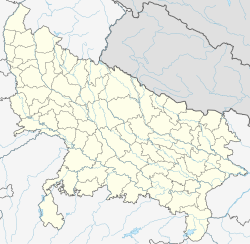Top Qs
Timeline
Chat
Perspective
Tarapur, Raebareli
Village in Uttar Pradesh, India From Wikipedia, the free encyclopedia
Remove ads
Tarapur is a village in Chhatoh block of Rae Bareli district, Uttar Pradesh, India.[2] As of 2011, Tarapur has a population of 1,010 people, in 183 households.[2] It has one primary school and no healthcare facilities.[2] It belongs to the nyaya panchayat of Hajipur.[3]
The 1951 census recorded Tarapur as comprising 3 hamlets, with a total population of 282 people (162 male and 120 female), in 68 households and 62 physical houses.[4] The area of the village was given as 421 acres.[4] 1 resident was literate.[4] The village was listed as belonging to the pargana of Rokha and the thana of Nasirabad.[4]
The 1961 census recorded Tarapur as comprising 3 hamlets, with a total population of 317 people (159 male and 158 female), in 76 households and 76 physical houses.[5] The area of the village was given as 421 acres.[5]
The 1981 census recorded Tarapur as having a population of 513 people, in 121 households, and having an area of 161.46 hectares.[6] The main staple foods were listed as wheat and rice.[6]
The 1991 census recorded Tarapur as having a total population of 585 people (300 male and 285 female), in 115 households and 115 physical houses.[3] The area of the village was listed as 161 hectares.[3] Members of the 0-6 age group numbered 120, or 20.5% of the total; this group was 53% male (63) and 47% female (57).[3] Members of scheduled castes made up 32.3% of the village's population, while no members of scheduled tribes were recorded.[3] The literacy rate of the village was 9% (49 men and 5 women).[3] 163 people were classified as main workers (152 men and 11 women), while 2 people were classified as marginal workers (both men); the remaining 320 residents were non-workers.[3] The breakdown of main workers by employment category was as follows: 121 cultivators (i.e. people who owned or leased their own land); 36 agricultural labourers (i.e. people who worked someone else's land in return for payment); 0 workers in livestock, forestry, fishing, hunting, plantations, orchards, etc.; 0 in mining and quarrying; 0 household industry workers; 0 workers employed in other manufacturing, processing, service, and repair roles; 0 construction workers; 1 employed in trade and commerce; 0 employed in transport, storage, and communications; and 5 in other services.[3]
Remove ads
References
Wikiwand - on
Seamless Wikipedia browsing. On steroids.
Remove ads


